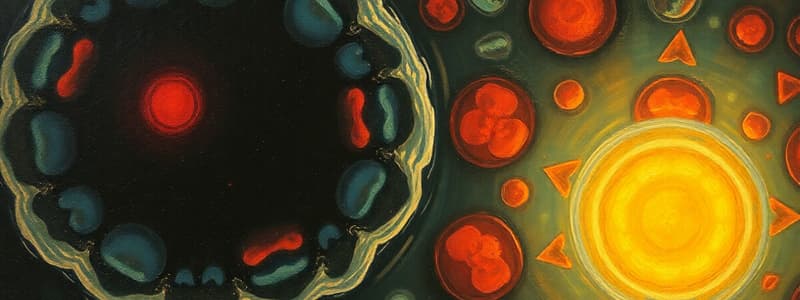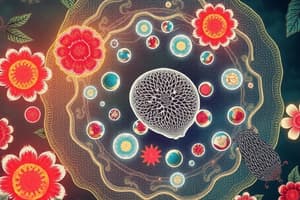Podcast
Questions and Answers
What is the main function of the cell membrane?
What is the main function of the cell membrane?
- Breaks down waste products
- Produces proteins for the cell
- Controls what goes in and out of the cell (correct)
- Provides structural support to the cell
Which organelle is responsible for making lipids and storing calcium ions?
Which organelle is responsible for making lipids and storing calcium ions?
- Rough ER
- Golgi Apparatus
- Nucleus
- Smooth ER (correct)
Which structure is involved in cellular respiration?
Which structure is involved in cellular respiration?
- Ribosomes
- Mitochondria (correct)
- Nucleus
- Chloroplast
What role do centrioles play during cell division?
What role do centrioles play during cell division?
Which organelle is unique to plant cells and is responsible for photosynthesis?
Which organelle is unique to plant cells and is responsible for photosynthesis?
Flashcards
What is the function of the cell membrane?
What is the function of the cell membrane?
The cell membrane controls what enters and leaves the cell, playing a crucial role in communication and maintaining a stable internal environment.
What is the role of ribosomes?
What is the role of ribosomes?
Ribosomes are responsible for protein synthesis, the production of new proteins.
What is the function of the nucleus?
What is the function of the nucleus?
The nucleus is the central control center of the cell, safeguarding the cell's DNA, which dictates all cellular activities.
What are mitochondria responsible for?
What are mitochondria responsible for?
Signup and view all the flashcards
What is the function of chloroplasts?
What is the function of chloroplasts?
Signup and view all the flashcards
Study Notes
Cell Organelles in Animal Cells (1-4) and Plant Cells (5-7)
- Cell Membrane: Controls what enters and exits the cell, maintaining homeostasis
- Cytoskeleton: Provides structure and support, holds everything in place and provides a solution for chemical reactions
- Cytoplasm: A solution where chemical reactions occur
- Nucleus: Protects the DNA, which controls cellular activities. It's surrounded by an envelope with pores.
- Nucleolus: Makes rRNA (part of ribosomes) inside the nucleus
- Ribosomes: Make proteins
- Rough ER: Makes proteins, packages them, and sends them to the Golgi apparatus
- Smooth ER: Makes lipids and stores calcium ions
- Golgi Apparatus: Processes, sorts, and ships proteins from the ER
- Lysosomes: Found in animal cells, break down dead stuff and do apoptosis
- Vacuoles: Stores water, nutrients, and waste
- Centrioles: Help pull chromosomes apart during cell division (called centrosomes when paired)
- Cilia: Small hair-like structures that move fluid across the cell surface.
- Flagella: Small tail-like structures that help cells move through fluid
- Mitochondria: Where cellular respiration occurs (ATP release)
- Chloroplasts: Where photosynthesis happens in plant cells
- Cell Wall: Plant cells use this to maintain shape (made of cellulose, chitin, or peptidoglycan)
- Central Vacuole: Found only in plant cells, massive storage units in the center of the cell.
Studying That Suits You
Use AI to generate personalized quizzes and flashcards to suit your learning preferences.





